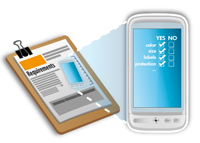
Some importers often over-estimate the amount of time it will take them to manage a third-party quality control (QC) firm. So I made a list of the main “touch points” and of the required steps.
Writing clear specifications and/or sending a reference sample
If you appoint an independent quality inspector and you want to make the most of his service, you need to give him the checkpoints. He will not guess what you want to see on your product & packing.
That’s a tradeoff between hiring your own QC staff and working with a service provider: your own staff will know exactly what is important, whereas an independent QC guy will need your input, preferably in a written and structured way.
But, guess what? Your suppliers also need these specifications in a written and structured way. If you weren’t doing it until now, it is a good idea to start right away…
Insisting on inspections, and tying payments to quality confirmations
If you pay for a QC inspection, you’d better use its findings to take a decision that is respected by your supplier, right? Then you need to do two things:
#1. Make sure your suppliers know that the inspection is not optional, that it will take 1-2 full days in their production schedule, and that they can’t ship out until they have your green light.
#2. Paying only after quality is confirmed. For more details, read this article if you pay by bank wire, and this one if you pay by letter of credit.
By the way, suppliers have a harder time challenging the motives of a third-party inspector (who simply records his findings) than those of a member of the importer’s staff (who might have been told to be particularly tough because this order actually didn’t sell all that well).
Booking the inspections
The inspection agency will need to know the factory address, the service date, and your product specifications. There are basically two ways this information can be provided:
- The supplier books the inspection (by filling out a special form), and the buyer sends the product specs on his side (by email).
- The importer must book the service by himself, and then the QC firm contacts the supplier to know the address and the date. I stopped counting the inspection firms that offer an “online booking system”. The ability to book an inspection on a website is appealing to some importers, but after some time they realize it can eat a lot of time.
Reading the inspection report template
If you use your own QC staff, you’ll likely have a very short (1 page) report after each day’s work. And that’s fine, since your employee knows (in theory) what is really important. On the contrary, a service provider works for hundreds/thousands of clients, and should report much more information — who knows what will make this customer tick?
In my view, the perfect report shows the most important information (the non-conformities to the buyer’s specs) toward the top of the report, and the least important at the bottom (most of the photos). It also tells the buyer on which pages the major problems are displayed.
Surprisingly, this is seldom the case. The trend over the past 10 years has been to display more and more photos in the body of the report, which means the purchaser needs to read through a 20- to 40-page report. Ouch!
General business relationship management
This generally takes a very insignificant amount of time. There are always a few emails to exchange. Approving invoices takes a few minutes at the end of the month. And that’s about it…
Except if you work with the wrong people and you have to send them complaints, of course!
No comments:
Post a Comment